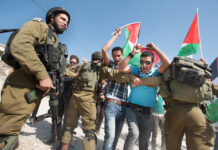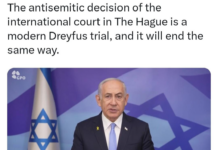A series of bloody clashes between rebel factions and the Islamic State of Iraq and Syria (ISIS) has left observers, more specifically, Muslims in a state of confusion and dismay, writes Ali Harfouch.
Rebels killing rebels, images of murdered Mujahirs (foreign fighters) created a sense of ambivalence which in turn produced reactionary discourses and actions across the Muslim world which consequently exacerbated the situation and further polarised the factions in Syria.
More so, many of these responses – emerging from both sides of the clash – are in fact based on misrepresentations of the ongoing clashes and are not based on an Islamic referent, at best they are reactionary and rhetorical. In what follows, we will address three critical dimensions of the revolution.
Reality of the Conflict
The infighting is not between “jihadi” factions and more “moderate” factions, as the Western pundits would like to portray it. Had it been a clash of ideologies, the factions which clashed with ISIS would also have targeted Jabhat an-Nusrah (JN) which pledged its allegiance to al-Qaeda.
As a matter of fact, many of the factions leading the clashes belong to the Islamic Front, have clearly disavowed themselves from the “moderate” and pro-Western opposition fronts in Syria. These clashes are thus between one faction (ISIS) and several other rebel factions. It is also worth noting that many of Syria’s leading rebel groups have abstained from the infighting.

During the peak of the clashes between Jaysh al-Mujahideen, the Syrian Revolutionary Front and ISIS, several major factions defected from the broad FSA-coalition and joined JN. If anything, the fact that all major factions, including the feuding factions, continue to espouse a radical Islamic discourse points to the reality that the direction of the revolution has not changed nor has it led to any major strategic-military setbacks.
Subscribe to our newsletter and stay updated on the latest news and updates from around the Muslim world!
Pro-regime figures as well as the defeatist Western-backed opposition have tried to attribute the recent fitna as being the product of the Syrian revolution itself. A cursory historical glance however points to a stark reality; the ISIS “phenomena” has existed long before the revolution in Syria broke out and has its roots in Iraq, if not (ideologically) far before.
Since Abu Mus’ab az-Zarqawi took power, he deployed a strategy which was at odds with al-Qaeda’s leadership and began a bloody streak against the Shiite population in Iraq as well as an all-out war on the so called “Sahwas” in Anbar (a Sunni-majority area). From the onset, az-Zarqawi and the ISI (Islamic State of Iraq) represented a fringe trend within the global jihadi movements as the scholars of the Salafiyah Jihadiyyah rebuked az-Zarqawi and the ISI soon after its inception. And thus, the recent infighting is neither primarily a product of the global jihadi movement nor that of the revolution in Syria but rather it is a continuity of the neo-Zarqawi trend.
Sources of rebel infighting
The revolution is unique in a number of ways; its Islamic sentiment, the diversity of rebel factions (in terms of leadership), its length and the number of antagonistic forces trying to suppress the revolution. An Islamic revolution, lacking a united political leadership that is being fought by a multitude of regional and international powers is then, naturally and inevitably, not going to be as cinematic and “simple” as many would make it out to be.
Media deception, political maneuvers, economic incentives, armed intervention and numerous other means have been employed by almost a dozen nations, all of whom have a common interest in suppressing the Syrian revolution and pushing to a political compromise that involves a transitional government. A multifarious and international attempt to politically pressure the Syrian revolution through direct or indirect interference is bound to leave a heavy impact on rebel alliances.

Even those factions which have been externally-influenced are largely influenced at upper-levels of leadership. Meaning that “external relations” are between regional powers and individuals and not regional and/or international powers and the faction in its totality. The double-discourse employed by the leadership is starkly evident of such; whereas the leadership will employ a subtly conciliatory discourse on one hand they will continue to explicitly integrate the “radical” demands of the revolution into the discourse used internally, towards their rank-and-file. Observers, inside and outside Syria, overlook this critical point when they reduce the conflict to one between “agents” and the regime or “agents” and the Islamic factions.
During the Algerian revolution, the French intelligence units were able to successfully deride the revolution and turn a popular-based Islamic revolution into a fringe extremist-based bloodbath. Pakistani intelligence officers were able to turn Afghan and Arab fighters against one another during the post-Soviet era. Syria has the following nations actively employing their intelligence units to derail the revolution; the United States, France, the United Kingdom, Russia, Iran, the Syrian regime, Jordan, Iraq, Turkey, Kuwait, Saudi Arabia, Qatar and many more. And thus, one is left in awe that these clashes are actually not wider in scope and have remained limited to the targeting of one group.
Lessons from Islamic history
It is an open revolution, and by open I mean that there is no overarching political framework or armed committee which mitigates and orients the ranks of the rebels or even filters and manages those who “join” the revolution. In the midst of the instability, dozens have associated themselves with the revolution only to use it as a means to carry out gang-like activities, taking advantage of the people’s vulnerability.

The FSA in most parts of Syria has become infamous for its corruption, on all levels as many of its rank-and-file as well as leadership have turned out to be nothing more than warlords and gang-like armed groups. Generalising and misconstrued categories like “the rebels” or “the mujahideen” are misleading. Prior to the clashes with the ISIS, many of these very same corrupt factions clashed with JN and Ahrar ash-Sham only to be driven out of cities and regions they had controlled.
Infiltration, opportunism and infighting dates back far beyond the revolution in Syria – in fact – it began with the establishment of the Islamic State:
- The loftiest of armies, that of the Prophet Muhammad (saw) was infiltrated by the munafiqeen and other opportunists, on one occasion, during the Battle of the Ahzab, a third of the army abandoned the Prophet.
- After the death of the Prophet, the infighting was not between two factions in Madina but involved a conflict between the newly-born Islamic State and tribes of the Arabian Peninsula in its entirety.
- Under the rule of Ali ibn Abi Talib (ra), historians and scholars mention that the khawarijj had infiltrated the armies of Ali (ra) and Mu’awiyah (ra), and were instrumental in instigating the fighting which ensued between the two.
A critical and realist-study of the emergence of the first Islamic State, the leadership of the Prophet and the four rightly guided Caliphs provides lessons not in romanticism but insights into the reality of war and conflict.
Once again, to draw from the previous point, the transgression by certain rebel factions against the ISIS have, for a large part, gone unnoticed and ignored. Dozens of fighters from the ISIS have been executed at rebel checkpoints, taken captive, tortured – worse yet – during the recent clashes many of the ISIS fighter’s wives were taken captive for no other reason than being the wives of ISIS members.
Various factions have taken advantage of the ISIS’s weakness and the united assault on its strongholds joined the fight. These clashes are not a clash between the righteous and the evil or between the good and bad – both sides have become fraught with opportunists, be the informants or otherwise, seeking to reap fruits from the instability.
@asharfouch




















